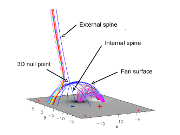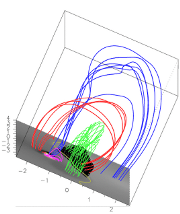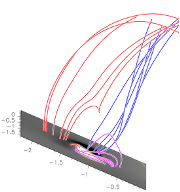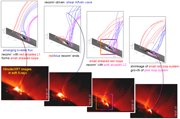
A variety of dynamic phenomena on the Sun, as for example soft X-ray jets and specific flares, have been associated with magnetic reconnection occuring in a 3D magnetic nullpoint topology consisting of a dome-like fan separatrix surface located below the nullpoint and a spine field line above it (Figure 1). Evidence for the presence of such a topology in the corona is provided by observations and magnetic field extrapolations, but its formation has not yet been studied in much detail. Since the embedding of a magnetic bipole in one polarity of a large-scale field naturally results in a 3D nullpoint topology (Figure 1), such configurations are expected to result from the relaxation of predominantly unipolar coronal fields (e.g., coronal holes) after reconnection with an emerging flux rope.
When small active regions form in coronal holes, they typically display an ''anemone''shape (a full or partial ring of radially aligned bright loops) and are associated with soft X-ray jets. Previous numerical simulations have shown that reconnection between an emerging flux rope and a unipolar coronal field indeed launches a hot jet. However, since only one polarity of the emerging bipole reconnects with the pre-existing field, hot loops were found in these simulations only on one side of the emerging flux. These simulations therefore did not yet provide a satisfying scenario for the formation of a full anemone of hot loops.
A dynamic event observed by Hinode/XRT on 24 April 2007 provides some clues on how full anemone regions may form. In this puzzling event, two small loop systems developed one after the other at the edge of a prominence cavity (Animation 1). The loop systems together temporary displayed an anemone shape. The formation of the first loop system, and the jet-like feature propagating above it along the cavity loops, indicates that a small bipole emerged aside the cavity.
In order to understand the full dynamics observed in this event (in particular the formation of the second loop system), we performed a 3D MHD simulation of the interaction of a small emerging flux rope with an arcade-like potential field overlying a large-scale coronal flux rope (the latter is intended to model the prominence cavity). We employ the flux rope model by Titov and Démoulin (1999) as initial condition for the coronal field, and we adopt the boundary-driven ''kinematic'' flux emergence technique by Fan and Gibson (1999) to emerge the flux rope.
The expansion of the emerging flux rope in the corona gives rise to the formation of a nullpoint at the interface of the emerging fields and the pre-existing coronal fields. We find a two-step nullpoint reconnection process that eventually yields the formation of a broad 3D fan-spine configuration above the emerging bipole. The magnetic field evolution is shown in Animations 2 and 3. The first animation shows a global view, and the second one shows a zoom into the emergence region.
The first reconnection occurs between the emerging flux rope (small blue field lines) and a set of large-scale arcade field lines (large red field lines) that is located on the left-hand side of the emerging bipole. Note that the reconnection launches a torsional MHD wave that propagates along the reconnected arcades (large blue field lines), since the reconnection transfers twist from the emerging rope into the coronal arcades. The reconnections results in the formation of small sheared loop system on the left-hand side of the emerging flux (small red field lines). The shear arises from the twist in the emerging flux rope. The upcoming field lines successively change their orientation during the emergence, which results in a sucessive displacement of the footpoints of the newly reconnected field lines towards the right-hand side of the flux rope.
The second reconnection occurs when the newly formed loops meet the remote arcade fields (large pink field lines), and yields the formation of a second loop system on the opposite side of the emerging flux (small pink field lines). This is an effect not yet seen in similar simulations. It occurs since the emerging flux is sufficiently twisted, i.e., the field line orientation changes along its cross-section. As the rope emerges, the appearing field lines are first oriented essentially antiparallel to the (red) arcade field lines on the left-hand side of the rope, hence these flux systems reconnect first. As the emergence proceeds, the changing orientation of the upcoming flux rope field lines successively displaces the footpoints of the newly reconnected small red field lines towards the pink arcade field lines on the right-hand side of the rope, until these two flux systems meet and start to reconnect.
Figure 2 shows a comparison of the XRT observation with magnetic field lines which are involved in the just described reconnections. Although no thermodynamics is included in the simulation, it can be assumed that field lines involved in the reconnection processes become heated and would hence show up in EUv and soft X-ray emission, which renders such a comparison reasonable. It can be seen that nature and timing of the features that occur in the simulation do qualititatively reproduce those observed by XRT in the particular event studied here.
Figure 3 displays the topological evolution of the system. It can be seen that, after the two reconnection events have occured, the two new loop systems collectively display an anenome pattern (located below the fan surface). The flux that surrounds the inner spine field line of the nullpoint retains a fraction of the emerged twist, while the remaining twist is evacuated along the reconnected arcades. The two-step reconnection process found in our simulation therefore suggests a new consistent and generic model for the formation of anemone regions in the solar corona.
This work has been published in the Astropysical Journal, see: Török et al. (2009)| @ |

|
T. Török, L. Van Driel, G. Valori, J.-M. Malherbe (Obs Paris) in collaboration with KU Leuven, HVAR, UNIGRAZ, UGOE |

|

|

|






